Arizona Geology Road Trip for Families
Arizona has so many amazing parks that it’s hard to plan a week-long trip. For Spring Break of 2017 we crammed one national park, three national monuments, a BLM landmark, and a privately managed natural landmark into six days. The pace was only possible because it was April. The weather was pleasant (60s-70s in the daytime), and the parks weren’t too crowded. We were so happy we visited in the Spring since the Summer of 2017 had record heat waves.
Arizona Road Trip Itinerary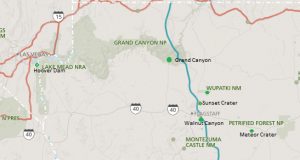
Day 1 – Fly into Las Vegas, Nevada
Day 2 – Hoover Dam and Drive to Flagstaff, Arizona
Day 3 – Meteor Crater and Walnut Canyon National Monument
Day 4 – Wupatki and Sunset Crater National Monuments
Day 5 – Lava River Cave and mountain biking in Flagstaff
Day 6 – Grand Canyon National Park – touring the rim
Day 7 – Grand Canyon National Park – hiking the Bright Angel Trail
Day 8 – Fly home from Flagstaff Pulliam Airport
Day 1 – Las Vegas, Nevada
Day 2 – Hoover Dam (click here to visit official website)
Location: Boulder City, Nevada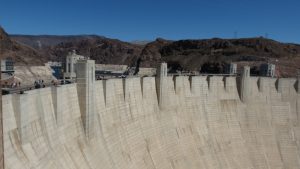
If you have the time, the hour-long Dam Tour was worth it ($30/person). These tickets are first-come first-served (We had to wait 2 hours before our tour started, but there was plenty to see and do during the wait.) The tour took us deep inside the Dam to see one of the giant generators. We were also able to look out of one of the air vents near the bottom of the Dam.
Recommended time: 2-4 hours, depending on the type of tour that you take
Food: There’s a snack bar that serves lunch and ice cream.
Cost: parking -$10, visitor center admission-$10 (no tour); Dam tour + admission-$30; Powerplant tour + admission -$15 adults, $12 juniors
Tips:
- Try to come early to beat the crowds and the heat. When we arrived, we had to wait two hours for our tour to begin.
- It’s hot and sunny there (be prepared for the heat).
- The Dam tour is for 8 year olds and up. If your children don’t like walking a lot and listening to adults talk about construction for an hour, you should probably consider just visiting the visitor’s center.
- You can buy tickets for the Power Plant Tour online through a third party vendor in advance if you are travelling during a peak season and are afraid the tours will book up before you arrive.
Day 3 – Meteor Crater and Walnut Canyon
Meteor Crater (click here to visit official website)
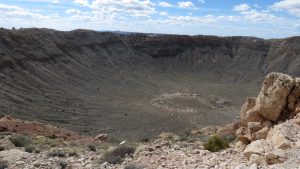
Location: off Interstate 40, Winslow, Arizona
Depending on which family member you asked, Meteor Crater was “good” or “fabulous.” Some people saw a big hole. Some people (the really cool ones) saw an amazing impact event — the best preserved impact structure on the planet.
After teaching astronomy for years, I was so excited to see Meteor Crater. My kids were less excited. I think they liked the gift shop more. I don’t care because I got to buy my very own piece of meteorite from the impact. We also took an hour-long tour on the rim with an excellent guide. It was cool seeing how the rocks on the side of the rim were overturned and thrown out of place. Please note, the tour only goes along the rim. You cannot go down to the bottom (nor do you want to go down to the bottom).
Geology of the Park: This is the best preserved impact structure in the world. It has an excellent exhibit on the geology of the region and impact events. (click this link for more information)
Recommended time: 2-3 hours, depending on whether you take a tour
Food: There’s a Subway restaurant that serves lunch and ice cream.
Cost: kids (ages 6-17) $9; adults $18
Tip: Try to come early before it gets too windy (the wind picks up during the day). If it’s too windy, they have to cancel the rim tours.
Walnut Canyon National Monument (click here to visit official website)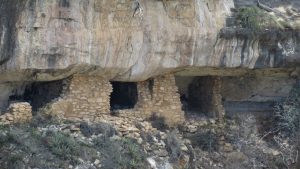
Location: off Interstate 40, Flagstaff, Arizona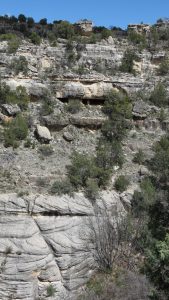
Walnut Canyon was an intriguing glimpse into Sinagua culture that lived in Northern Arizona during from 600-1400 AD. Both kids enjoyed hiking the Island Trail, which takes you down into the canyon to see and walk among the cliff dwellings that were built between 1125-1250 AD. The kids were also able to see how the vegetation changed between the north-facing and south-facing sides and how that would affect the people living there.
Geology of the Park: The cliff dwellings were built into natural ledges formed in the Kaibab Limestone. There were spectacular views of cross-bedding in the Coconino Sandstone.
Food: no food available (park is 10 miles outside Flagstaff)
Cost: kids (ages 16 and under) free; adults $10
Tip: If you have to pick between the Island Trail and the Rim Trail, do the Island Trail. You can go inside the cliff dwellings. It’s a neat experience that everyone can appreciate. The Rim trail doesn’t give you that opportunity. One of our kids got bored on the Rim Trail (it was a long day at that point – time to go home).
Day 4 – Sunset Crater Volcano and Wupatki National Monuments
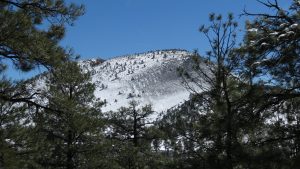 Sunset Crater National Monument (click here to visit official website)
Sunset Crater National Monument (click here to visit official website)
Location: Highway 89, Flagstaff, Arizona
We started at the Visitor’s Center to learn more about the volcanoes in Arizona. Then we headed off to hike the Lenox Crater Trail and see fields of aa lava in the Lava Flow Trail. This was my third visit to Sunset Crater. As a kid, I remembered hiking in a lava cave with my family, but that seems to be closed now. Darn!
Geology of the Park: Amazing cinder cone volcanoes that erupted around 1085. It’s like a textbook lesson about volcanoes, but these volcanoes are not on a plate margin. Geologists think Arizona volcanoes might be due to a hotspot. (for more information click here)
Recommended time: 2-3 hours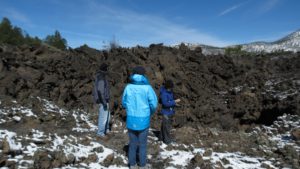
Food: no food available
Cost: both monuments are included in the $20/vehicle fee
Tips
- Definitely hike the Lava Flow Trail. The kids enjoyed hiking and climbing on the rocks. The Lenox Crater Trail was less popular with the kids since it was uphill and more of a scenery tour. I think this hike gave the park a lower rating with the kids.
- Bring a picnic or bag lunch and plenty of water. Both monuments are far from town, and it is easier to bring a lunch and eat it at the picnic ground. We ate our lunch on the road while driving to Wupatki on the Loop Road that connects the two parks.
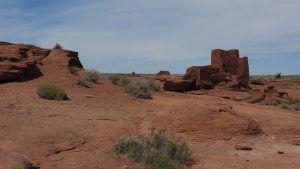
Wukoki Pueblo
Wupatki National Monument (click here to visit official website)
Location: Highway 89, Flagstaff, Arizona
Our first introduction to the park was the striking, desolated Wukoki Pueblo. Unlike Walnut Canyon, the housing style is not cliff dwelling but pueblo style complexes. At the Visitor’s Center, you can take a self-guided tour through the Wupatki Pueblo which has about 100 rooms! You can really get a sense of how the people lived there. They even made a ballcourt.
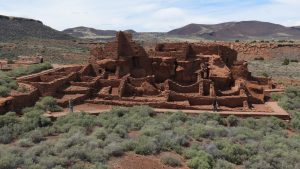
Wupatki Pueblo
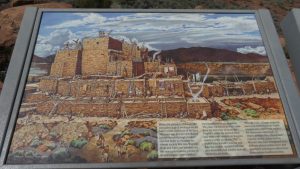
Geology of the Park: As you drive on the Loop Road from Sunset Crater, you can see the lava flows resting on top of the sedimentary rocks (which is very cool). Most of the pueblos appear to be built in the reddish Moenkopi Formation. The Sinaguans used rocks from the Kaibab Limestone and Moenkopi Formations to build their structures. Because of fracturing in the Kaibab Limestone, there is a “blowhole” air vent connecting to an underground fracture located in the Ballcourt of the Wupatki Pueblo.
Recommended time: 2-3 hours
Food: no food available.
Cost: both monuments are included in the $20/vehicle fee
Tips:
- Bring your own lunch and drinks.
- If you only have time to visit one pueblo, I recommend visiting Wupatki pueblo. If your kids are not budding archaeologists, consider just visiting 1-2 pueblo sites. After the second pueblo site, we should have called it a day. (But no! We did a third pueblo, and that is why this park got a 3.5 rating with the kids. See the Kids’ Ratings below)
Day 5 – Lava River Cave and Mountain Biking
Lava River Cave, Flagstaff Area
There are many reviews about this cave on the web. Some of the reviews make it sound like anyone can visit. I don’t recommend the cave, for safety reasons. Also, the forest service road can be impassable in bad weather. This cave is 3/4 mile long. We walked about half of the cave before we turned back. The kids loved it, but it is not for the faint of heart. You could get seriously hurt in the cave, and young children should not do it, especially in the winter when there’s ice in the cave. When we went in April, it had just snowed and there were snowdrifts on the road. We weren’t sure if the road was passable. If you go, you must be equipped with flashlights (at least one per person). Wear warm clothing and good hiking boots. It’s cold in there. You may want to consider wearing hardhats too. I whacked my head pretty hard on the cave ceiling. When we entered the cave, we descended down a ten foot frozen waterfall. Once, inside the cave, we were able to stand up, but the cave floor was very slippery and many rocks wobbled as you walked on them.
Mountain Biking
Location: Campbell Mesa, Flagstaff (click here for an interactive trail map)
We rented mountain bikes in town and did the “beginner” loop trails at Campbell Mesa on the outskirts of Flagstaff. The whole family biked the 1.7 Continental Loop and the 5.7 Campbell Mesa Loop. That was enough for the kids and me. My husband kept biking and added the Walnut Meadow Loop. It took us about 1 1/4 hours to bike the loops. I was the slowest biker (of course). The scenery was beautiful. We had amazing views of the volcanoes of the Flagstaff area.
Lowell Observatory (click here for official website)
Location: 1400 W. Mars Hill Road, Flagstaff, AZ
If the skies are clear, it is worth visiting Lowell Observatory in Flagstaff. We attended a talk on Stars and Galaxies and then got to look through three telescopes. I saw a globular cluster and the Orion Nebula (the nebula in Orion’s Belt).
Days 6 and 7 – The Grand Canyon (click here for official website)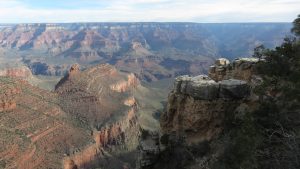
About 25 years ago, I was a Student Conservation Association intern at the Yavapai Geology Museum at the Grand Canyon. I got to work with the park rangers for three months one Fall. In my free time, I had the chance to hike many different trails, cross-country ski, horseback ride, bike, and explore along the South Rim of the canyon. My favorite trails, Hermit Trail and Grandview Trail, were not good candidates for our kids due to our limited time at the park.
Visitors Center: Definitely worth a visit to get oriented and watch a movie about the canyon.
Rim Trail: This trail is a must. Try to get away from the crowds. I saw some really cool fossils (coral and sponge) in the Kaibab Limestone along the rim trail west of the Hermit’s Rest Shuttle Bus stop.
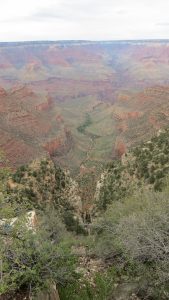
Looking down at the Bright Angel Trail
Bright Angel Trail: We decided on this trail because we could walk to it from our hotel and it had rest rooms. In warmer months, it also has water available. We only went down to the 1.5 mile rest stop (which had a restroom). This was far enough for our family to get the experience of the canyon. It was cool looking at evidence of Bright Angel Fault displacement along the trail. Walking to this rest stop, we saw the Kaibab Limestone, Toroweap Formation, Coconino Sandstone, and the Hermit Shale.
Recommended time: 2-3 days
Food: Many options. We ate breakfast at the Bright Angel Lodge and dinner at the El Tovar (I made dinner reservations a month in advance). We made sandwiches for lunch for our hike into the canyon. There is a grocery store at the Canyon village.
Cost: $30 entrance fee
Tips:
- Book park lodging early (as in months in advance)
- Don’t overtax your kids.
- Bring Purell. Somewhere along the way, we picked up a stomach bug.
- Parking is really tight. Come early to get a spot.
- The Hermit Trailhead Shuttle bus takes 80 minutes to do the 14 mile roundtrip without getting off the bus. We got on the bus thinking it would be a 10 minute ride out to Hermit’s Rest. We didn’t know it made stops along the way. The shuttle was very crowded, with people in the aisles. In hindsight, we should have just walked along the rim.
General Tips for The Arizona Geology Road Trip
- Know the weather before you go. We had snow during our stay in Flagstaff, and it was cold at night. The elevation in Flagstaff and the south rim of the Grand Canyon is around 7,000 feet. We packed winter clothes and a few summer items like t-shirts and shorts. We rarely wore the light clothing.
- Pack sturdy water bottles for hiking trips (obviously they need to be empty for the airlines) and bring a backpack for stuff.
- Don’t rely on fast food chains because there are few places to stop for lunch. Five out of seven days, we ate a bag lunch prepared in the morning. Often, we ate lunch while driving between parks. Also, bring lots of snacks
- Invest in good hiking boots for everyone. Sneakers don’t provide the footing or ankle support that you need on a trail.
- If you want to stay overnight at the Grand Canyon, you need to book early. I booked our hotel rooms at the Grand Canyon a year in advance to make sure that we got adjoining rooms in a convenient location.
- Don’t overtax your kids. We were at the 1.5 mile rest stop on the Bright Angel Trail, and we saw a lot of teary-eyed kids. It’s not worth the trouble.
- Don’t expect your kid to look at the scenery all the time. For us, the car rides were breaks for the kids between the parks. They needed down time (and unfortunately, screen and phone time).
- Consider buying the annual national park pass for $80.
Kids’ Ratings – Scale of 1 (worst) to 5 (best)
Hoover Dam: 4.5
Meteor Crater: 4.4
Walnut Canyon Ruins: 4.25
Sunset Crater Volcanoes: 3.5
Wupatki Ruins: 3.5
Lava Cave: 5.5
Mountain Biking: 3.3
Rim walk at Grand Canyon: 4
Hike into the Grand Canyon: 4.5
